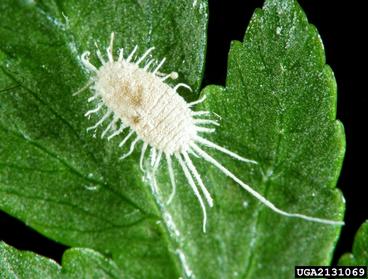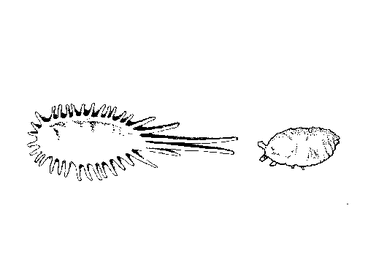SCIENTIFIC NAME: Pseudococcus longispinus (Targioni-Toetti)
CLASS: Insecta
ORDER: Hemiptera
FAMILY: Pseudococcidae


Description
Adult Females
Up to 3 millimeters long, female longtailed mealybugs have 17 pairs of waxy filaments around the periphery. On mature specimens, the caudal (tail) filaments are as long as or longer than the yellowish to grayish body (unless the tail filaments have broken off). Overall length may be 6 to 7 millimeters.
Eggs
There is no external egg stage of the longtailed mealybug.
Nymphs
The nymph is similar to the larger adult female except that the filaments around the edges are shorter.
Biology
Host Plants
Longtailed mealybugs have been found on at least 26 plant families. Dracaena appears to be the favored host, but most flowering and ornamental foliage plants are susceptible.
Damage
Longtailed mealybugs feed by sucking out plant sap from leaves and stems. Honeydew and sooty mold further disfigure infested plants, which may eventually be killed. These pests also secrete a fluffy white wax which also detracts from the appearance of infested plants.
Life Cycle
Although longtailed mealybugs were first described in 1867, not much has been published on their biology. Females give birth to live young on a shallow pile of white waxy secretions. Because the females are wingless, the must be brought into proximity of a host plant before it can be infested.
Management Strategies
Biological Control
A small wasp, Anagrus nigricornis, parasitizes longtailed mealybugs, and a small, predaceous, brown lacewing insect feeds on them. Ants sometimes protect longtailed mealybugs from parasites and predators and feed upon the honeydew excreted by these mealybugs.
Pesticides
Longtailed mealybugs are sometimes difficult to control, even though there is no egg stage protected by a dense ovisac. If many plants are infested, they should be dipped or sprayed thoroughly with a pesticide mixture or the entire greenhouse treated with an aerosol. It is best to treat again two or more times at weekly intervals. Retreatment will control mealybugs that were missed by earlier control efforts.